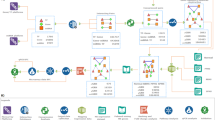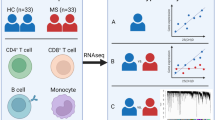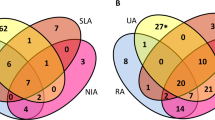Abstract
Interferon-β (IFN-β) is one of the major drugs for multiple sclerosis (MS) treatment. The purpose of this study was to characterize the transcriptional effects induced by intramuscular IFN-β-1a therapy in patients with relapsing–remitting form of MS. By using Affymetrix DNA microarrays, we obtained genome-wide expression profiles of peripheral blood mononuclear cells of 24 MS patients within the first 4 weeks of IFN-β administration. We identified 121 genes that were significantly up- or downregulated compared with baseline, with stronger changed expression at 1 week after start of therapy. Eleven transcription factor-binding sites (TFBS) are overrepresented in the regulatory regions of these genes, including those of IFN regulatory factors and NF-κB. We then applied TFBS-integrating least angle regression, a novel integrative algorithm for deriving gene regulatory networks from gene expression data and TFBS information, to reconstruct the underlying network of molecular interactions. An NF-κB-centered sub-network of genes was highly expressed in patients with IFN-β-related side effects. Expression alterations were confirmed by real-time PCR and literature mining was applied to evaluate network inference accuracy.
This is a preview of subscription content, access via your institution
Access options
Subscribe to this journal
Receive 6 print issues and online access
$259.00 per year
only $43.17 per issue
Buy this article
- Purchase on Springer Link
- Instant access to full article PDF
Prices may be subject to local taxes which are calculated during checkout




Similar content being viewed by others
Accession codes
References
Weiner HL . The challenge of multiple sclerosis: how do we cure a chronic heterogeneous disease? Ann Neurol 2009; 65: 239–248.
Compston A, Coles A . Multiple sclerosis. Lancet 2008; 372: 1502–1517.
Bradl M, Lassmann H . Progressive multiple sclerosis. Semin Immunopathol 2009; 31: 455–465.
Sospedra M, Martin R . Immunology of multiple sclerosis. Annu Rev Immunol 2005; 23: 683–747.
Jacobs LD, Cookfair DL, Rudick RA, Herndon RM, Richert JR, Salazar AM et al. Intramuscular interferon beta-1a for disease progression in relapsing multiple sclerosis. Ann Neurol 1996; 39: 285–294.
Jacobs LD, Beck RW, Simon JH, Kinkel RP, Brownscheidle CM, Murray TJ et al. Intramuscular interferon beta-1a therapy initiated during a first demyelinating event in multiple sclerosis. N Engl J Med 2000; 343: 898–904.
Limmroth V, Malessa R, Zettl UK, Koehler J, Japp G, Haller P et al. Quality Assessment in Multiple Sclerosis Therapy (QUASIMS): a comparison of interferon beta therapies for relapsing-remitting multiple sclerosis. J Neurol 2007; 254: 67–77.
Stark GR . How cells respond to interferons revisited: from early history to current complexity. Cytokine Growth Factor Rev 2007; 18: 419–423.
Gilli F, Marnetto F, Caldano M, Sala A, Malucchi S, Di Sapio A et al. Biological responsiveness to first injections of interferon-beta in patients with multiple sclerosis. J Neuroimmunol 2005; 158: 195–203.
Santos R, Weinstock-Guttman B, Tamaño-Blanco M, Badgett D, Zivadinov R, Justinger T et al. Dynamics of interferon-beta modulated mRNA biomarkers in multiple sclerosis patients with anti-interferon-beta neutralizing antibodies. J Neuroimmunol 2006; 176: 125–133.
Weinstock-Guttman B, Bhasi K, Badgett D, Tamaño-Blanco M, Minhas M, Feichter J et al. Genomic effects of once-weekly, intramuscular interferon-beta1a treatment after the first dose and on chronic dosing: Relationships to 5-year clinical outcomes in multiple sclerosis patients. J Neuroimmunol 2008; 205: 113–125.
Weinstock-Guttman B, Badgett D, Patrick K, Hartrich L, Santos R, Hall D et al. Genomic effects of IFN-beta in multiple sclerosis patients. J Immunol 2003; 171: 2694–2702.
Waubant E, Vukusic S, Gignoux L, Dubief FD, Achiti I, Blanc S et al. Clinical characteristics of responders to interferon therapy for relapsing MS. Neurology 2003; 61: 184–189.
Kappos L, Clanet M, Sandberg-Wollheim M, Radue EW, Hartung HP, Hohlfeld R et al. Neutralizing antibodies and efficacy of interferon beta-1a: a 4-year controlled study. Neurology 2005; 65: 40–47.
Goertsches RH, Hecker M, Zettl UK . Monitoring of multiple sclerosis immunotherapy: from single candidates to biomarker networks. J Neurol 2008; 255 (Suppl 6): 48–57.
Comabella M, Martin R . Genomics in multiple sclerosis - current state and future directions. J Neuroimmunol 2007; 187: 1–8.
Hesse D, Krakauer M, Lund H, Søndergaard HB, Limborg SJ, Soelberg Sørensen P et al. Disease protection and interleukin-10 induction by endogenous interferon-beta in multiple sclerosis? Eur J Neurol 2010; e-pub ahead of print 15 June 2010; doi:10.1111/j.1468-1331.2010.03116.x.
Sellebjerg F, Krakauer M, Hesse D, Ryder LP, Alsing I, Jensen PE et al. Identification of new sensitive biomarkers for the in vivo response to interferon-beta treatment in multiple sclerosis using DNA-array evaluation. Eur J Neurol 2009; 16: 1291–1298.
Singh MK, Scott TF, LaFramboise WA, Hu FZ, Post JC, Ehrlich GD . Gene expression changes in peripheral blood mononuclear cells from multiple sclerosis patients undergoing beta-interferon therapy. J Neurol Sci 2007; 258: 52–59.
Fernald GH, Knott S, Pachner A, Caillier SJ, Narayan K, Oksenberg JR et al. Genome-wide network analysis reveals the global properties of IFN-beta immediate transcriptional effects in humans. J Immunol 2007; 178: 5076–5085.
Hecker M, Lambeck S, Toepfer S, van Someren E, Guthke R . Gene regulatory network inference: data integration in dynamic models - a review. Biosystems 2009; 96: 86–103.
Cho KH, Choo SM, Jung SH, Kim JR, Choi HS, Kim J . Reverse engineering of gene regulatory networks. IET Syst Biol 2007; 1: 149–163.
Ross AP . Tolerability, adherence, and patient outcomes. Neurology 2008; 71 (24 Suppl 3): S21–S23.
McDonald WI, Compston A, Edan G, Goodkin D, Hartung HP, Lublin FD et al. Recommended diagnostic criteria for multiple sclerosis: guidelines from the International Panel on the diagnosis of multiple sclerosis. Ann Neurol 2001; 50: 121–127.
Ferrari F, Bortoluzzi S, Coppe A, Sirota A, Safran M, Shmoish M et al. Novel definition files for human GeneChips based on GeneAnnot. BMC Bioinformatics 2007; 8: 446.
Hecker M, Goertsches RH, Engelmann R, Thiesen HJ, Guthke R . Integrative modeling of transcriptional regulation in response to antirheumatic therapy. BMC Bioinformatics 2009; 10: 262.
Yang IV, Chen E, Hasseman JP, Liang W, Frank BC, Wang S et al. Within the fold: assessing differential expression measures and reproducibility in microarray assays. Genome Biol 2002; 3: research0062.
Falcon S, Gentleman R . Using GOstats to test gene lists for GO term association. Bioinformatics 2007; 23: 257–258.
Mahony S, Benos PV . STAMP: a web tool for exploring DNA-binding motif similarities. Nucleic Acids Res 2007; 35 (Web Server issue): W253–W258.
Efron B, Hastie T, Johnstone I, Tibshirani R . Least angle regression. Ann Statist 2004; 32: 407–499.
Killcoyne S, Carter GW, Smith J, Boyle J . Cytoscape: a community-based framework for network modeling. Methods Mol Biol 2009; 563: 219–239.
Clauset A, Shalizi CR, Newman MEJ . Power-law distributions in empirical data. SIAM Review 2009; 51: 661–703.
Melchjorsen J, Kristiansen H, Christiansen R, Rintahaka J, Matikainen S, Paludan SR et al. Differential Regulation of the OASL and OAS1 Genes in Response to Viral Infections. J Interferon Cytokine Res 2009; 29: 199–208.
Ishibashi K, Kuwahara M, Gu Y, Tanaka Y, Marumo F, Sasaki S . Cloning and functional expression of a new aquaporin (AQP9) abundantly expressed in the peripheral leukocytes permeable to water and urea, but not to glycerol. Biochem Biophys Res Commun 1998; 244: 268–274.
Kraft S, Kinet JP . New developments in FcepsilonRI regulation, function and inhibition. Nat Rev Immunol 2007; 7: 365–378.
Giorelli M, Livrea P, Defazio G, Iacovelli L, Capobianco L, Picascia A et al. Interferon beta-1a counteracts effects of activation on the expression of G-protein-coupled receptor kinases 2 and 3, beta-arrestin-1, and regulators of G-protein signalling 2 and 16 in human mononuclear leukocytes. Cell Signal 2002; 14: 673–678.
Hamilton JA . CSF-1 signal transduction. J Leukoc Biol 1997; 62: 145–155.
Huang W-X, Huang MP, Gomes MA, Hillert J . Apoptosis mediators fasL and TRAIL are upregulated in peripheral blood mononuclear cells in MS. Neurology 2000; 55: 928–934.
Wandinger KP, Lünemann JD, Wengert O, Bellmann-Strobl J, Aktas O, Weber A et al. TNF-related apoptosis inducing ligand (TRAIL) as a potential response marker for interferon-beta treatment in multiple sclerosis. Lancet 2003; 361: 2036–2043.
Kimberley FC, Screaton GR . Following a TRAIL: update on a ligand and its five receptors. Cell Res 2004; 14: 359–372.
Tanaka N, Kawakami T, Taniguchi T . Recognition DNA sequences of interferon regulatory factor 1 (IRF-1) and IRF-2, regulators of cell growth and the interferon system. Mol Cell Biol 1993; 13: 4531–4538.
Mizugishi K, Aruga J, Nakata K, Mikoshiba K . Molecular properties of Zic proteins as transcriptional regulators and their relationship to GLI proteins. J Biol Chem 2001; 276: 2180–2188.
Stürzebecher S, Maibauer R, Heuner A, Beckmann K, Aufdembrinke B . Pharmacodynamic comparison of single doses of IFN-beta1a and IFN-beta1b in healthy volunteers. J Interferon Cytokine Res 1999; 19: 1257–1264.
Buchwalder PA, Buclin T, Trinchard I, Munafo A, Biollaz J . Pharmacokinetics and pharmacodynamics of IFN-beta 1a in healthy volunteers. J Interferon Cytokine Res 2000; 20: 857–866.
Stürzebecher S, Wandinger KP, Rosenwald A, Sathyamoorthy M, Tzou A, Mattar P et al. Expression profiling identifies responder and non-responder phenotypes to interferon-beta in multiple sclerosis. Brain 2003; 126 (Part 6): 1419–1429.
Annibali V, Di Giovanni S, Cannoni S, Giugni E, Bomprezzi R, Mattei C et al. Gene expression profiles reveal homeostatic dynamics during interferon-beta therapy in multiple sclerosis. Autoimmunity 2007; 40: 16–22.
Goertsches RH, Hecker M, Koczan D, Serrano-Fernandez P, Moeller S, Thiesen HJ et al. Long-term genome-wide blood RNA expression profiles yield novel molecular response candidates for IFN-beta-1b treatment in relapsing remitting MS. Pharmacogenomics 2010; 11: 147–161.
Kraus J, Bauer R, Chatzimanolis N, Engelhardt B, Tofighi J, Bregenzer T et al. Interferon-beta 1b leads to a short-term increase of soluble but long-term stabilisation of cell surface bound adhesion molecules in multiple sclerosis. J Neurol 2004; 251: 464–472.
Floris S, Ruuls SR, Wierinckx A, van der Pol SM, Döpp E, van der Meide PH et al. Interferon-beta directly influences monocyte infiltration into the central nervous system. J Neuroimmunol 2002; 127: 69–79.
Calvete JJ . On the structure and function of platelet integrin alpha IIb beta 3, the fibrinogen receptor. Proc Soc Exp Biol Med 1995; 208: 346–360.
Stalker TJ, Wu J, Morgans A, Traxler EA, Wang L, Chatterjee MS et al. Endothelial cell specific adhesion molecule (ESAM) localizes to platelet-platelet contacts and regulates thrombus formation in vivo. J Thromb Haemost 2009; 7: 1886–1896.
Ishida T, Kundu RK, Yang E, Hirata K, Ho YD, Quertermous T . Targeted disruption of endothelial cell-selective adhesion molecule inhibits angiogenic processes in vitro and in vivo. J Biol Chem 2003; 278: 34598–34604.
Weber C, Fraemohs L, Dejana E . The role of junctional adhesion molecules in vascular inflammation. Nat Rev Immunol 2007; 7: 467–477.
Montalban X, Durán I, Río J, Sáez-Torres I, Tintoré M, Martínez-Cáceres EM . Can we predict flu-like symptoms in patients with multiple sclerosis treated with interferon-beta? J Neurol 2000; 247: 259–262.
Nie D, Tang K, Diglio C, Honn KV . Eicosanoid regulation of angiogenesis: role of endothelial arachidonate 12-lipoxygenase. Blood 2000; 95: 2304–2311.
Pidgeon GP, Tang K, Cai YL, Piasentin E, Honn KV . Overexpression of platelet-type 12-lipoxygenase promotes tumor cell survival by enhancing alpha(v)beta(3) and alpha(v)beta(5) integrin expression. Cancer Res 2003; 63: 4258–4267.
Shelhamer JH, Marom Z, Kaliner M, Sun F, Bach MK . The effects of arachinoids and leukotrienes on the release of mucus from human airways. Chest 1982; 81: 36S–37S.
Emerson MR, LeVine SM . Experimental allergic encephalomyelitis is exacerbated in mice deficient for 12/15-lipoxygenase or 5-lipoxygenase. Brain Res 2004; 1021: 140–145.
Wang X, Newkirk RF, Carre W, Ghose P, Igobudia B, Townsel JG et al. Regulation of ANKRD9 expression by lipid metabolic perturbations. BMB Rep 2009; 42: 568–573.
Tamura K, Makino A, Hullin-Matsuda F, Kobayashi T, Furihata M, Chung S et al. Novel lipogenic enzyme ELOVL7 is involved in prostate cancer growth through saturated long-chain fatty acid metabolism. Cancer Res 2009; 69: 8133–8140.
Tremlett H, Oger J . Hepatic injury, liver monitoring and the beta-interferons for multiple sclerosis. J Neurol 2004; 251: 1297–1303.
Comabella M, Lünemann JD, Río J, Sánchez A, López C, Julià E et al. A type I interferon signature in monocytes is associated with poor response to interferon-beta in multiple sclerosis. Brain 2009; 132 (Part 12): 3353–3365.
Acknowledgements
We deeply thank Peter Lorenz for helpful discussions and our lab assistants Gabriele Gillwaldt, Silvia Dilk, Ina Schröder and Ildikó Tóth for their help in performing the experiments. We are also grateful to study nurse Christa Tiffert for her invaluable contribution. This study was supported by grants from the German Federal Ministry of Education and Research (BMBF, BioChancePlus, 0313692D), and partially funded by Biogen Idec.
Author information
Authors and Affiliations
Corresponding author
Ethics declarations
Competing interests
Professor Dr Zettl has received research support, as well as speaking fees from Bayer, Biogen Idec, Merck Serono, Sanofi Aventis and Teva. Mr Hecker, Dr Goertsches, Mr Fatum, Dr Koczan, Prof Dr Thiesen and Dr Guthke declare no potential conflict of interest.
Additional information
Supplementary Information accompanies the paper on the The Pharmacogenomics Journal website
Supplementary information
Rights and permissions
About this article
Cite this article
Hecker, M., Goertsches, R., Fatum, C. et al. Network analysis of transcriptional regulation in response to intramuscular interferon-β-1a multiple sclerosis treatment. Pharmacogenomics J 12, 134–146 (2012). https://doi.org/10.1038/tpj.2010.77
Received:
Revised:
Accepted:
Published:
Issue Date:
DOI: https://doi.org/10.1038/tpj.2010.77
Keywords
This article is cited by
-
Elastic net-based prediction of IFN-β treatment response of patients with multiple sclerosis using time series microarray gene expression profiles
Scientific Reports (2019)
-
Interferon-beta therapy in multiple sclerosis: the short-term and long-term effects on the patients’ individual gene expression in peripheral blood
Molecular Neurobiology (2013)
-
Elevated type I interferon-like activity in a subset of multiple sclerosis patients: molecular basis and clinical relevance
Journal of Neuroinflammation (2012)
-
Pharmacogenomics and Multiple Sclerosis: Moving Toward Individualized Medicine
Current Neurology and Neuroscience Reports (2011)



